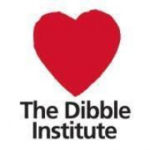Mind Matters: Empowering Young People with Skills to Support Their Mental Wellbeing
- Global Health
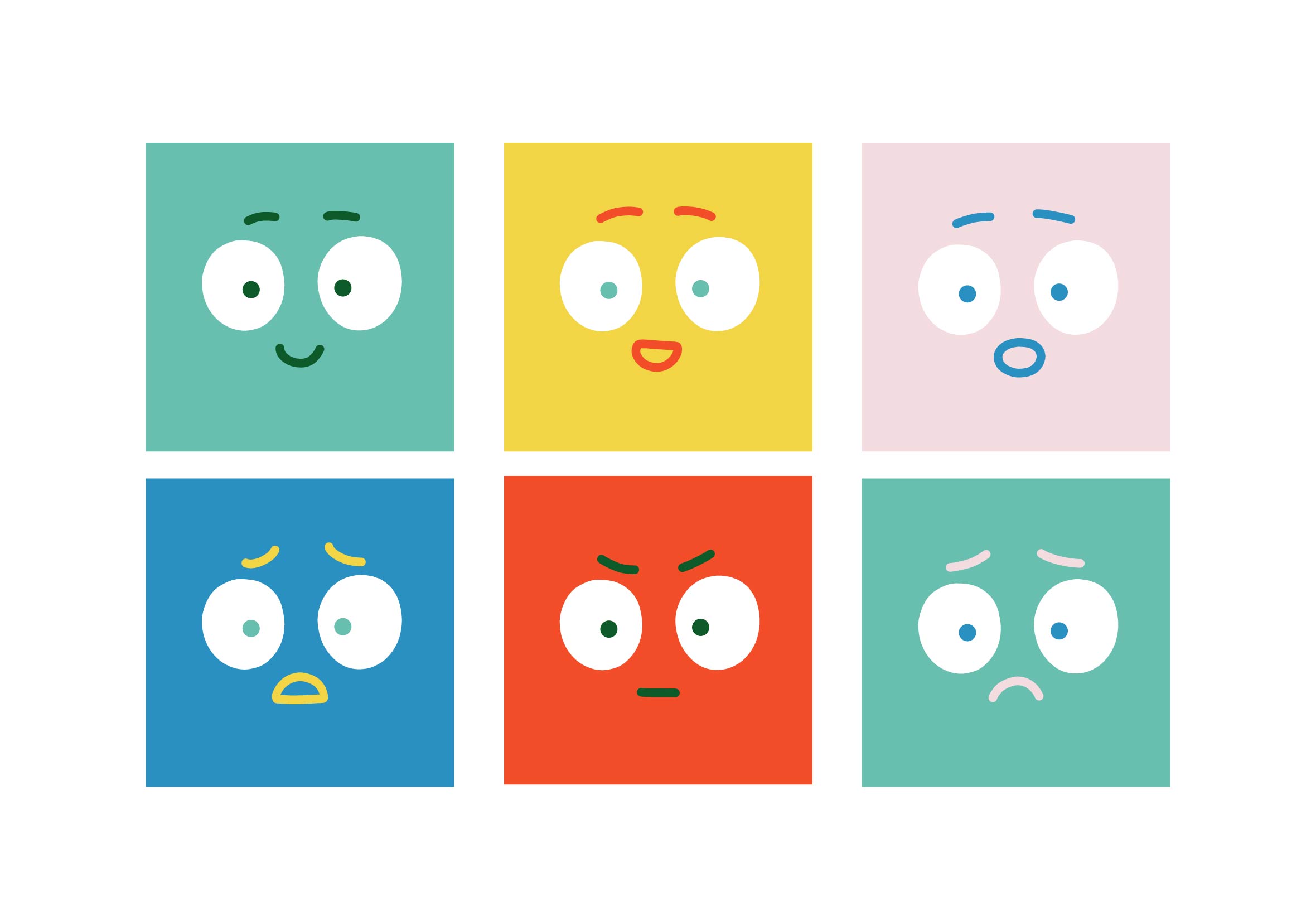
In the Spring of 2021, Designmatters partnered with The Dibble Institute, a nonprofit publisher specializing in materials that helps young people build strong and healthy emotional connections. This Designmatters studio challenged transdisciplinary ArtCenter students to take the Institute’s new curriculum, Mind Matters: Overcoming Adversity and Building Resilience which has been designed for in-person classroom instruction, and create a remote, engaging and effective version of the mental wellbeing program, resources and exercises that can be accessed directly to young people through online platforms.
The result was the Me&MyEmotions website and videos, launched by The Dibble Institute in Fall 2021.
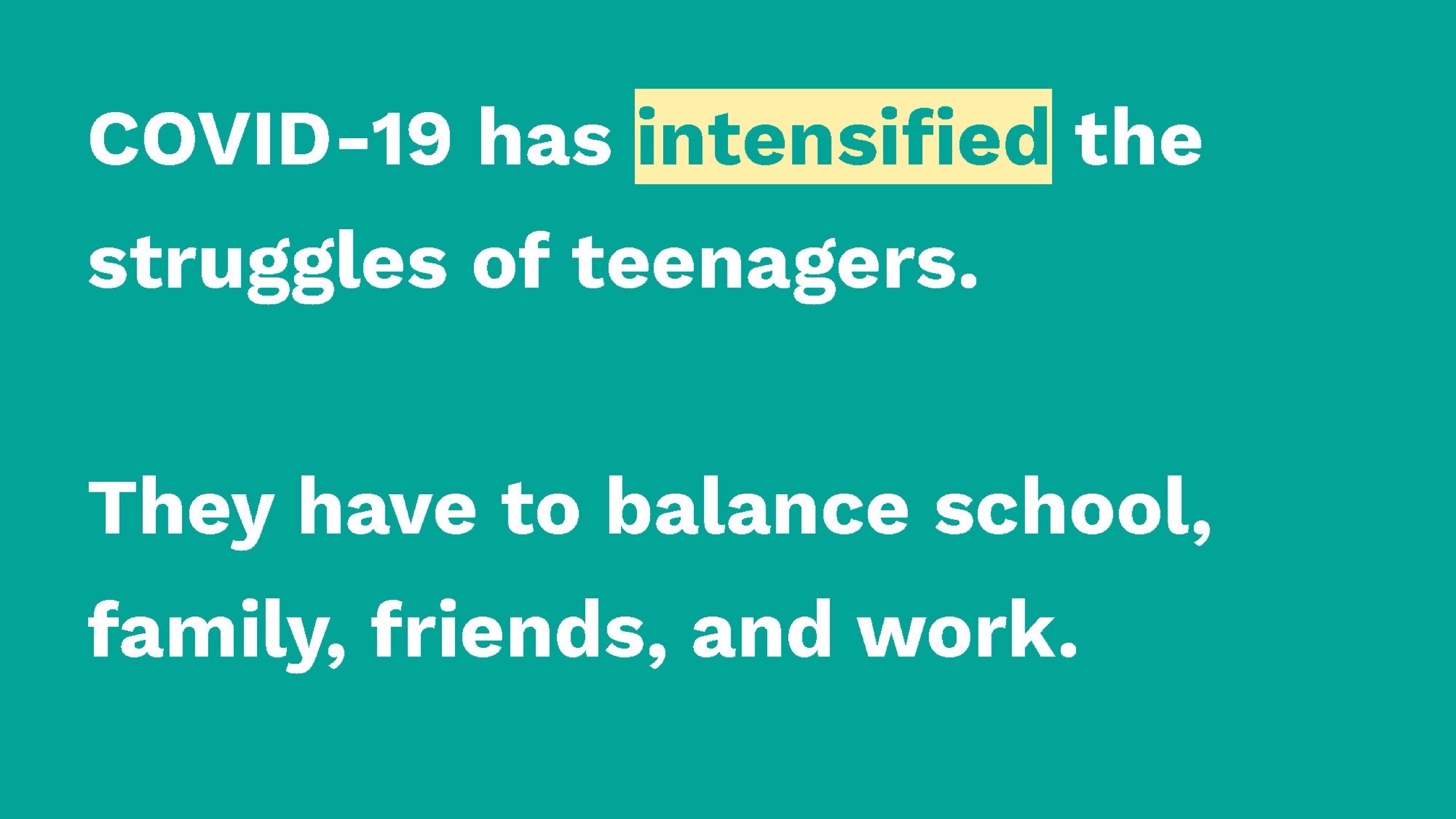
Project Brief
In partnership with The Dibble Institute this Designmatters studio challenged transdisciplinary ArtCenter students to re-imagine the Institute’s Mind Matters curriculum, meant for in-person instruction, and create a remote but equally effective version of this mental wellbeing program, it’s engaging exercises and techniques that can be directly targeted to young people through online platforms.
Co-creating with Dibble, students worked as one unifying team to design an empathy-based holistic strategy that drew inspiration from extensive research, guest expert lectures and immersive experiences.
“The pandemic really pushed forward the importance of mental wellbeing and how it cannot be swept under the rug to be dealt with later. It became essential to be resilient. MindMatters provides science-backed skills for teens to become more resilient, which is important in both normal and in times of adversity, like what we are facing now. I really appreciate this approach to mental wellbeing as a skill that anyone is capable of learning.”
Judy Toretti, Faculty
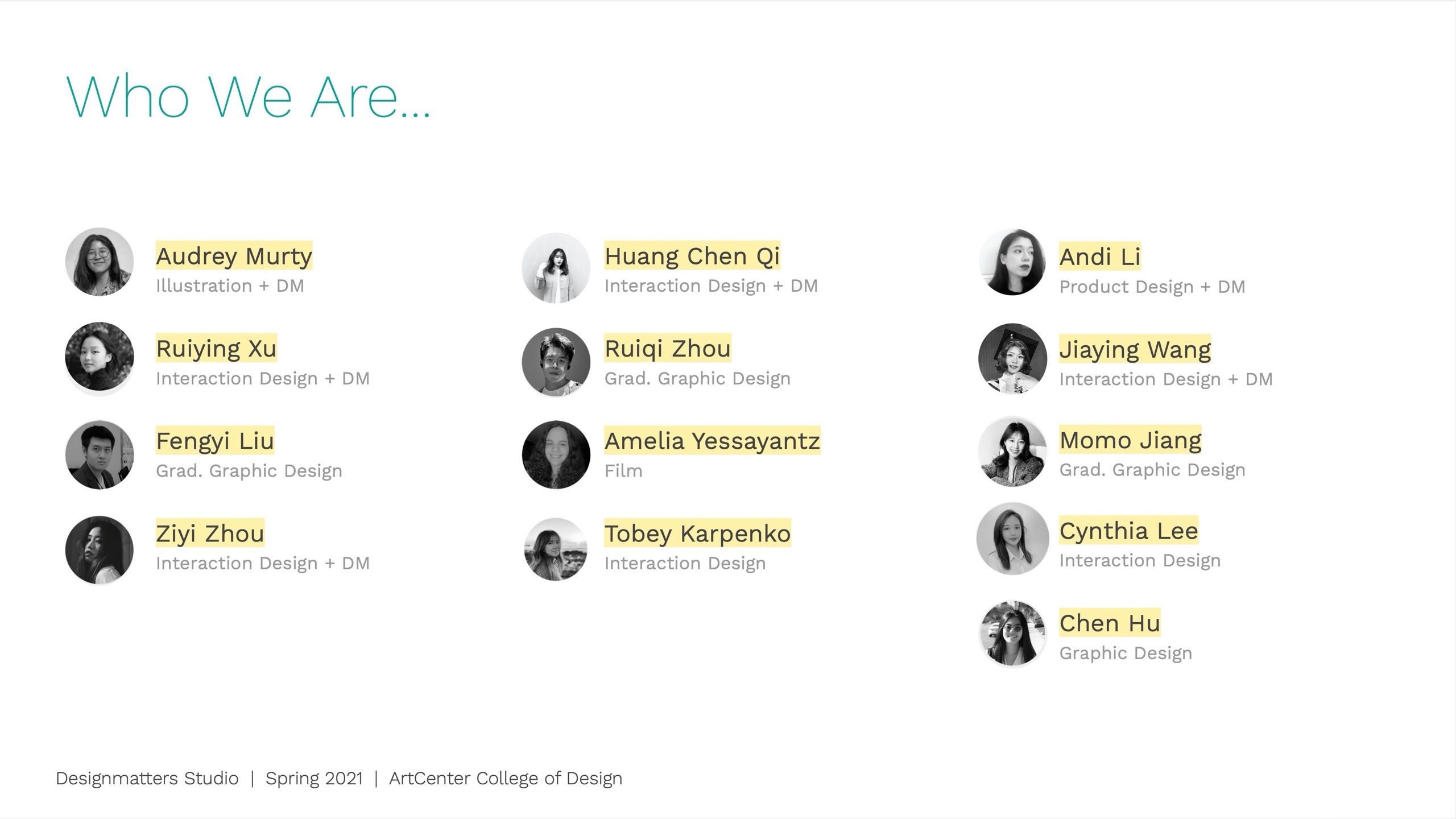
“Working with other majors, wonderful teams and amazing teachers has allowed me to learn so many new things. Most importantly, all the different ways that great educational content can be re-interpreted and adapted to different platforms, all to positively impact people’s lives.”
Amelia Yesayantz, Film Student
About The Dibble Institute and the Mind Matters Program
The Dibble Institute is a national, independent nonprofit that promotes relationship training for youth — especially in the context of dating and romantic connections.
Mission:
Empowering teens and young adults with knowledge and evidence-based skills to successfully navigate their intimate relationships.
As a non-profit curriculum publisher, we support organizations with:
- Best practices curricula
- Professional training
- Connections to funding opportunities
- Ongoing technical assistance
Vision:
We strive for a world where more young people are making healthy relationship choices and more children are being raised in safe, stable, and nurturing families.
Dibble’s newly launched Mind Matters curriculum invites participants – many who might be facing challenges in school, life and relationships – to learn skills and strategies to take charge of their emotions and improve their states of mind. Participants learn to address their physical, relational and mental wellbeing needs by developing positive habits which can lead to long-lasting resiliency and character.
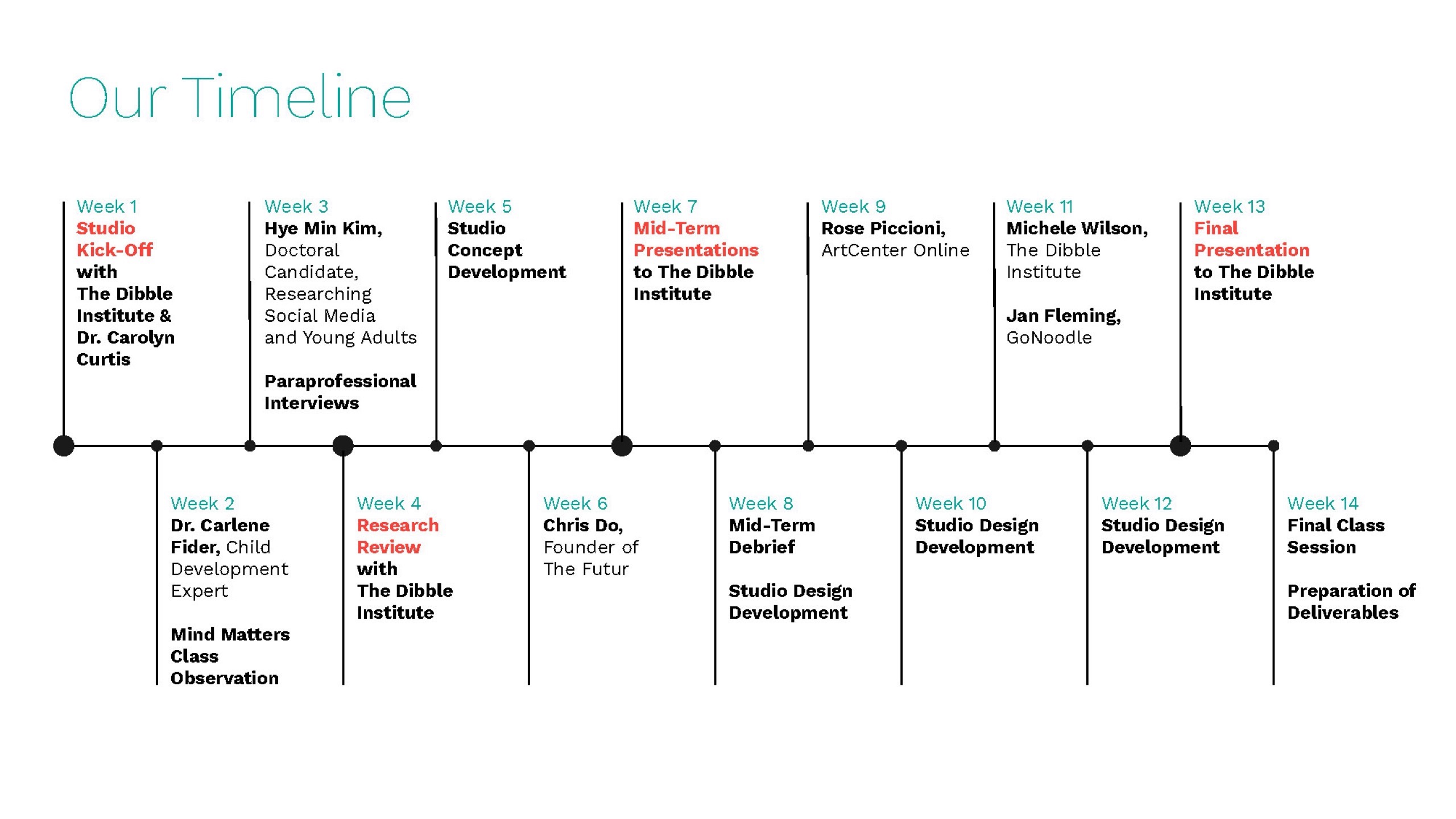
Research and Project Development
At the studio kickoff, ArtCenter students were introduced to The Dibble Institute team who shared their overriding mission and described their newest program, Mind Matters which targets teens ages 13 and older. The program teaches practical but innovative methods for participants to learn self-care habits and skills that promote healthier reactions to difficult experiences. While therapeutic in nature, the program is not intended to replace traditional one-on-one therapy.
Students heard a presentation on the complexities of Adverse Childhood Experiences (ACE), learning how past traumatic experiences can impact teens’ ability to have healthy emotional connections with themselves, their families and their interpersonal relationships.
To introduce ArtCenter students to the Mind Matters curriculum sections, Dibble facilitators – including Carolyn Curtis who developed the program – walked through the key learning objectives.
Students learned about the Mind Matter’s Pinwheel Curl motif that incorporates the psycho-emotional skills embodied in the program’s six sections:
- Self-soothing
- Observing self
- Supportive relationship
- Self-care
- Intentionality
- Compassion for the ‘hijacked’ brain
Each program section incorporates an interactive exercise and techniques that participants can use to create healthy habits of mind. ArtCenter students engaged in a Mind Matters breathing exercise and a 5-4-3-2-1 exercise designed to increase mindfulness in times of a crisis. Students learned about other Mind Matters exercises that included: journaling, identifying trusted people, the importance of sleep/exercise, goal-setting and realization that change is possible.
ArtCenter students had opportunities to ask questions to Dibble about the program, how it was designed to be taught in-person with a facilitator/teacher, key elements that needed to carry over into a virtual platform and more. Dibble team members requested that the solution should not be simply a mobile application, but rather a holistic digital experience. An active discussion involved which parts of the current program needed to be incorporated into the digital one: the Must Haves, the Could Haves, the Should Haves and the Won’t Haves.
As they processed that information, ArtCenter students next heard about the psychology of teenagers from Dr. Carlene O. Fider, professor of Psychology at Pacific Oaks College, who discussed the importance of resilience when it comes to teens’ mental wellbeing. Dr. Fider explained the different types of resiliency: natural (born with it), adaptive (something forced) and restored (learned). She described factors contributing to resiliency and offered strategies that build that skill. Dr. Fider stressed this process does take time and intention; building emotional resiliency is similar to physically building a muscle.
ArtCenter students asked thoughtful questions about the developing brain of an adolescent, how they learn, how social media influences them, and how pandemic isolation has contributed to more teens struggling with mental wellbeing issues.
“The Dibble Institute provided our students direct access to so many Mind Matters experts: from Dr. Carolyn Curtis, creator of the curriculum, to paraprofessionals including a Zoom observation of a class in progress, to working on content with Michele Wilson, a master Mind Matters trainer. This increased the class’s understanding of the methodology and provided a strong foundation for their proposals. Feedback at the research review and mid-term presentations was thoughtful and extensive, and we appreciated the comments that challenged the students to rethink and refine certain aspects their work.”
Monica Schlaug, Faculty
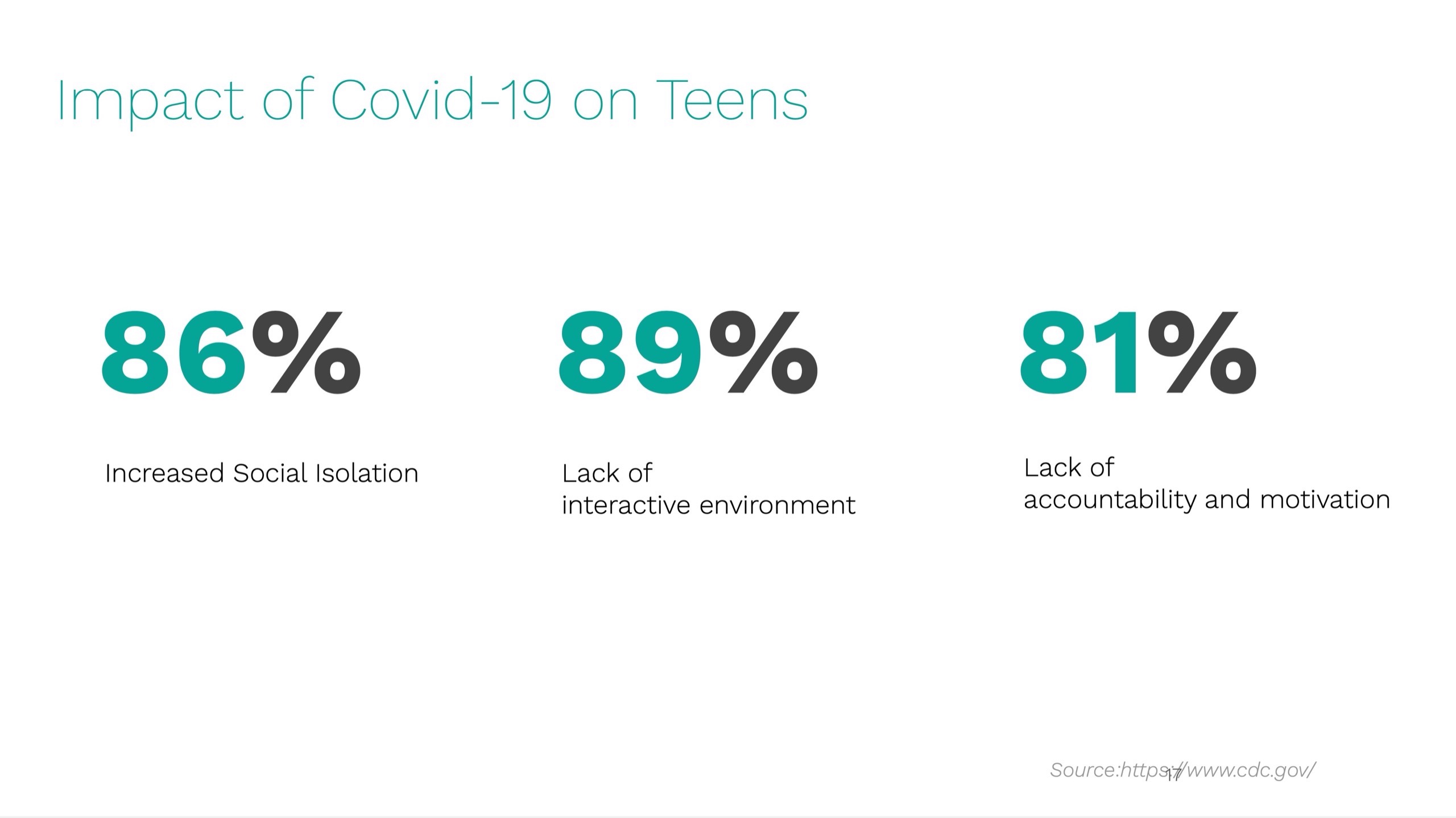
During this research phase, where student teams also interviewed paraprofessionals who administer the Mind Matters curriculum, students were invited to virtually observe a class of high schoolers in Cody, Wyoming during their health class where a teacher was facilitating the Mind Matters material. This first-hand observation gave ArtCenter students better understanding of how the program is implemented in a classroom setting.
At the end of the Wyoming class, ArtCenter teams asked the high school students about their social media use, how they handled stress and what they liked about the Mind Matters program; overwhelmingly, it was the exercises.
ArtCenter students were divided into teams as they delved further into this research phase, discovering social media habits of teens, the importance of habits, popular mobile apps that teens use and how gamification can engage teens on many levels.
“I did not expect mental wellbeing to be such a big problem for adolescents, and it helps me to reflect on my own childhood experience and I learned something about myself. I am looking forward to seeing this work be eventually launched and helpful to many adolescents.”
Tobey Karpenko, Interaction Design student with Designmatters Minor in Social Innovation
Research Review
To help synthesize information gathered in the initial weeks of the studio, ArtCenter student teams presented their research findings/statistics and key insights to each other and the Dibble team. Teams also shared teen personas, possible strategies, competitor audits, inspiration from other sources, and their rough branding concepts and styles.
Feedback from Dibble was crucial at this time for the teams to move forward; additionally Dibble witnessed how student teams grasped the fundamental concepts of the Mind Matters program and an empathetic understanding of the target audience. Teams also demonstrated their comprehension of how healthy habits are formed, and the current trends in mental wellbeing and wellness.
Teams described solutions that could include collaboration with social media influencers, gamifying content, inspirational video campaigns – but emphasized that the content needed to be simple and customizable, friendly and fun while creating a peer-to-peer community feel.
As teams continued their research and further developed their concepts, subject matter experts gave classroom virtual lectures on relatable topics: Hye Min Kim, a doctoral candidate described her research on social media and young adults; Chris Do of offered insights on successful educational platforms; Rose Piccioni provost of Online Education at ArtCenter shared how virtual learning can efficiently engage students; and Jan Fleming of GoNoodle described how its online products for kids reflect social-emotional values.
“…thank you SO MUCH for the great presentations. It’s a very well-thought and designed project that I’ve learned so much from and it’s just so impressive to see it involves so many great insights on different points including content, brands, and ads. Looking forward to following up more on how this proposal continues.”
Hye Min Kim, doctoral candidate at the Annenberg School for Communication and Journalism
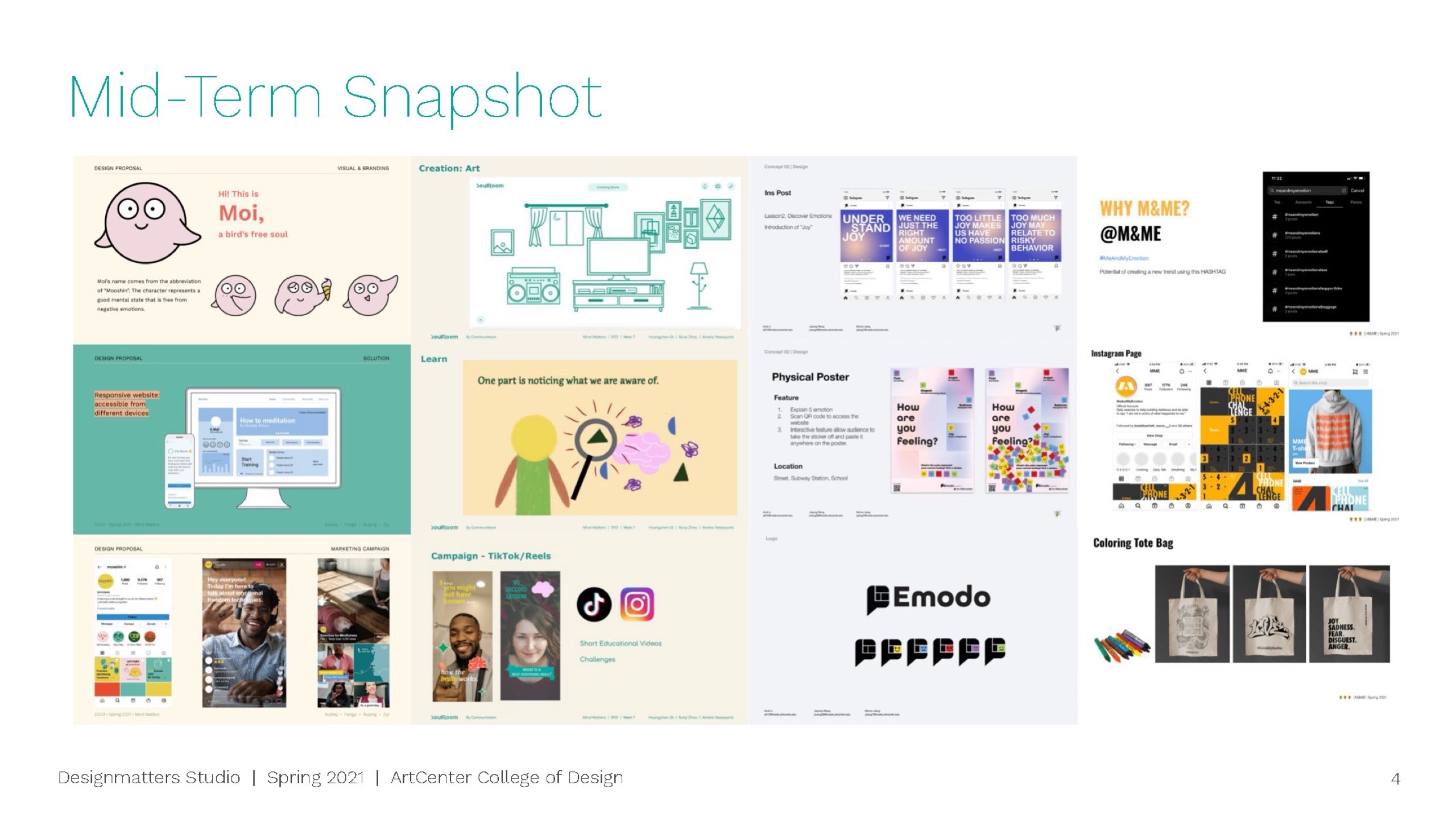
Midterm Presentations
Once again, student teams met with Dibble to gauge their design direction. Teams presented refined ideations, outlined a user journey and created mood boards that illuminated their thought process. As they presented, teams shared their mission statements, insights on their audience and extensive research that informed their user insights and distinct design proposals. Teams described their visual branding concepts along with appropriate color schemes, typography and character logo designs. Marketing campaign promotions and rollout were also discussed along with metrics that could measure the success of such a campaign.
The Dibble Team responded with concrete feedback pointing out possibilities, suggesting and re-directing design ideations.
“All the students wanted this project to be successful. Their research in the early weeks was deep and thorough; their design proposals were thoughtful and on-target. ArtCenter prepares students to successfully complete their projects, but we wanted our students to also learn to be flexible, collaborative, and present research-backed and insight-driven solutions. As working professionals, Monica and I tried to bring ‘real world’ experiences into the studio and openly discussed with the students the challenges they will face after school, especially how to communicate with and manage a client.”
Judy Toretti, Faculty

“This concept was very well thought out, built on the Mind Matters curriculum with teens as the primary target. The concepts are on target.”
The Dibble Institute Team
A new strategy
Up until this time, students had been divided into four distinct teams, but it became evident that these teams had similar focus with many overlapping elements. The faculty team realized that a better use of resources and overall classroom experience would be to consolidate the students as one team working on one holistic design. This arrangement proved mutually beneficial to students and the Dibble team. By creating one team with one set of deliverables, students gained real-world experience on how professional agencies work with clients on similar campaigns.
Four teams were created with members responsible for certain elements:
- Branding
- Website
- Social Media
- Marketing
Students checked in weekly as a class but continued to work deeper on their specific tasks. They connected with their fellow student/teammates, working to create a streamlined, seamless campaign that featured a single voice and design language.
“The Dibble Institute showed me how business people think differently from designers. They had many concerns and those became our design restrictions. We needed to learn how to communicate with our clients to get the best results. Some things are not the designer’s call; the client is crucial to the final outcomes. Overall, this experience was a peek of how design works in the real world.”
Chen Hu, Graphic Design Student
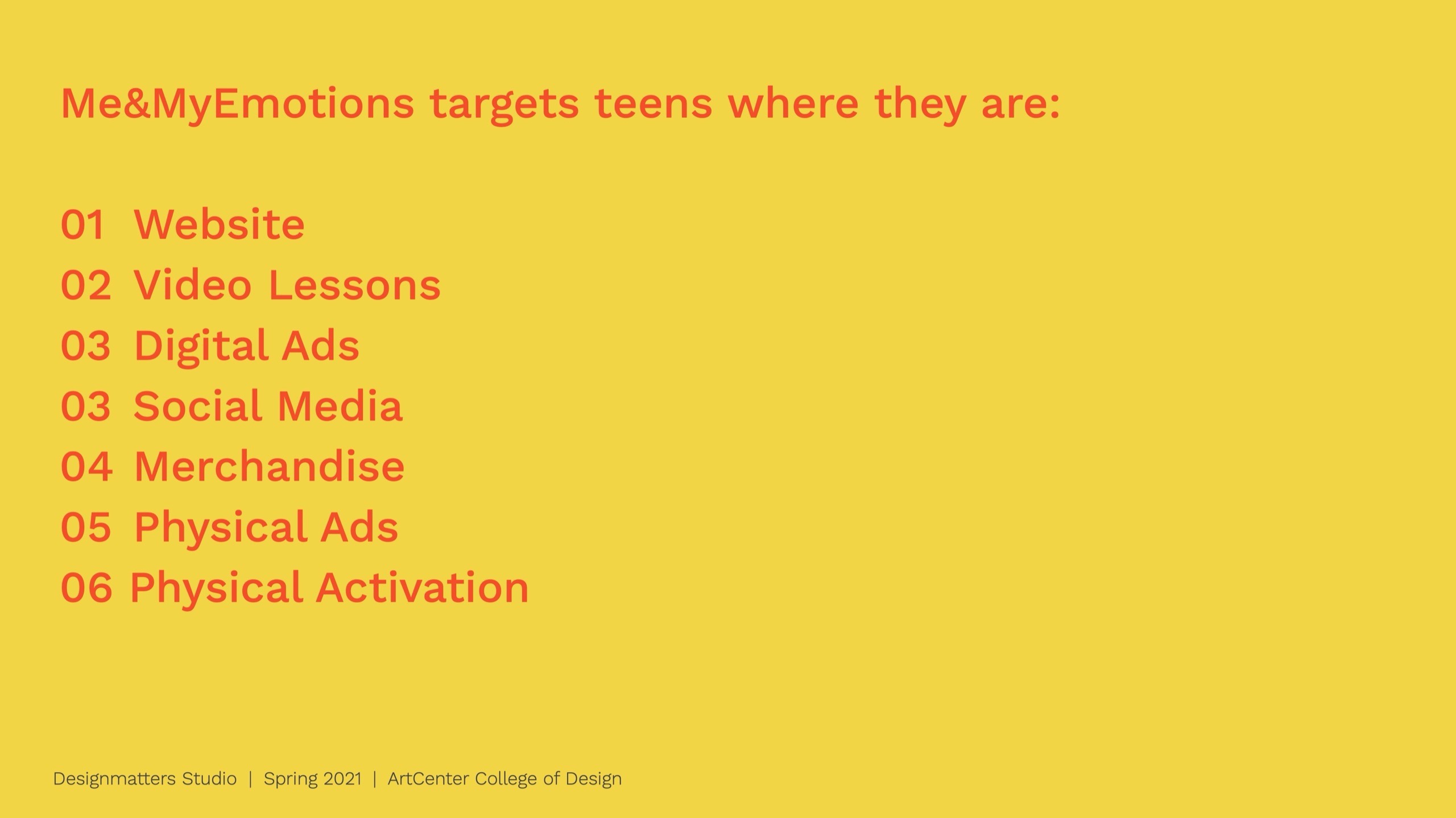
“Our students showed a great amount of dedication and teamwork throughout the course, particularly after the mid-term pivot to a single project. While it was challenging to align 13 creatives to one direction so quickly, it was a very realistic glimpse into what working within a large team for a single client or campaign entails. Even under the umbrella of the brand, students were able to propose specific design ideas uniquely tailored to the applications they were focusing on.”
Monica Schlaug, Faculty
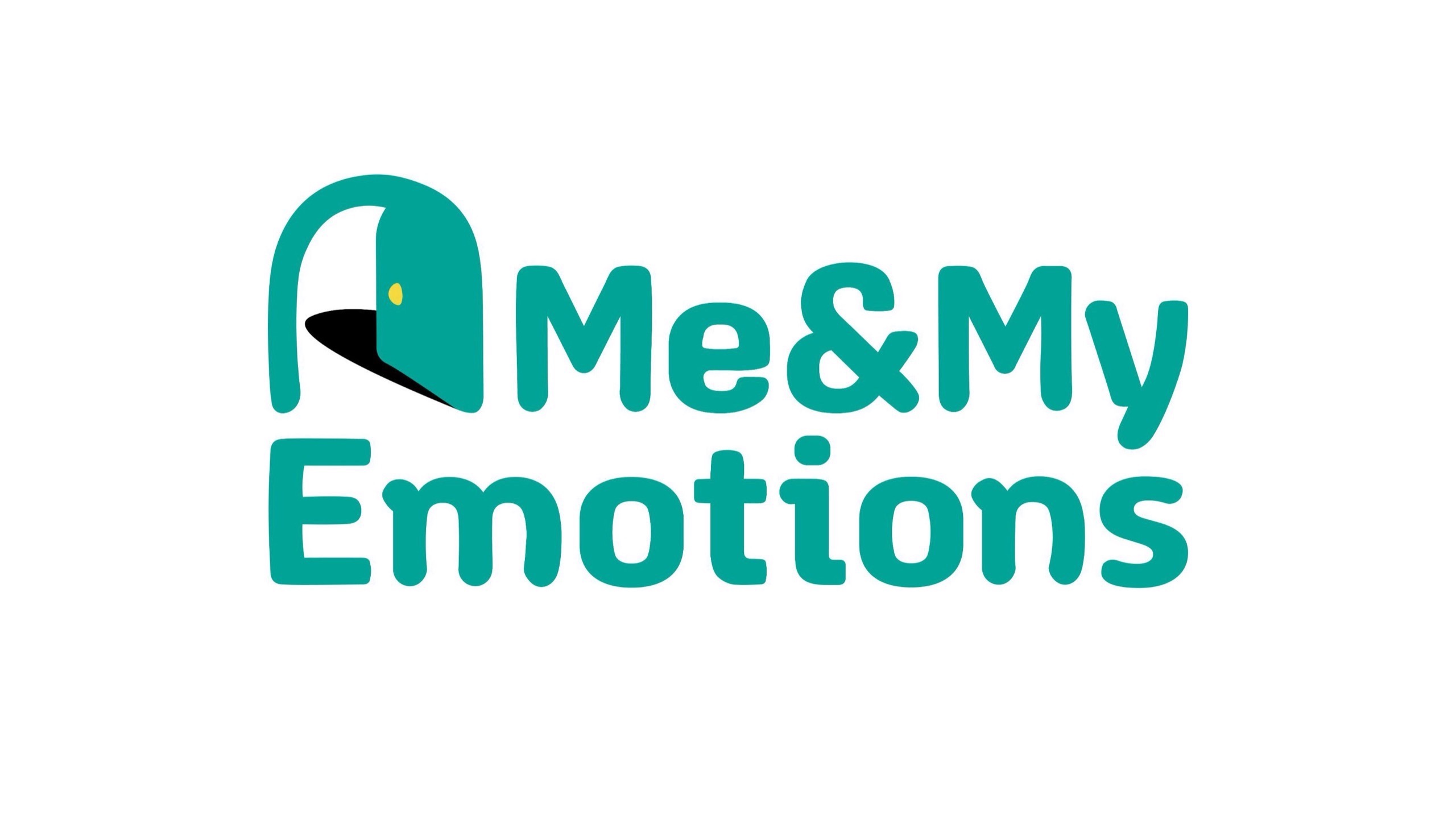
Project Outcome — Me&MyEmotions (MME)
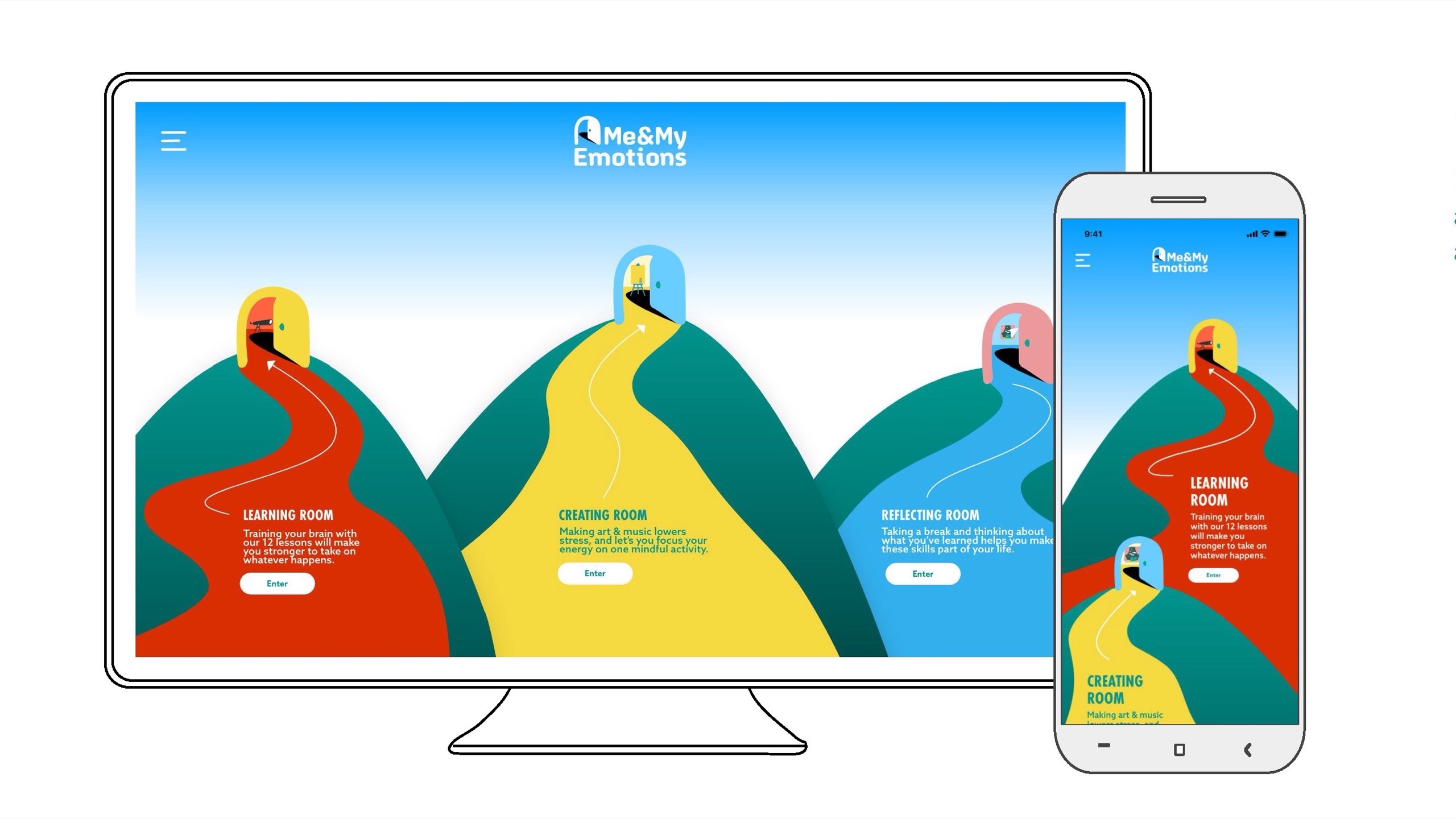
Website
Accessible on desktop and mobile devices, the Me&MyEmotions (MME) website welcomes teens to a safe space to explore, learn about and share their emotions. Before sending users to the landing page, a screen prompt provides content overview and a reminder that they are not alone in this journey. With a gentle cartoon-style graphic style, colorful landscape and a Pink Brain mascot, the landing page presents three options in the form of doors – a motif resembling the MME logo.
Teens set up their profile and can customize their personal “rooms” where later they can save/store other MME generated items such as artwork, journal entries, musical creations, etc. By choosing a favorite color, teens are automatically assigned into a specific community team. Teens create their own avatar-like imagery using pencil tools and geometric shapes.
Once they are officially a part of MME, teens decide which room to engage in: Learning, Reflecting or Creating. Each room has a distinct color background with fun and simple illustrations that represent the room’s objects and lessons.
In The Creating Room, users compose songs and design artwork that can be recorded and saved into their personal rooms.
The Reflecting Room encourages journal writing, a place to keep track of their morning routines and managing their calendar. Users can view past journal entries. The MME mascot can suggest a possible lesson/exercise for users to consider depending on the emotion/behavior/experience they are going through.
The proposed website will be built using WordPress and Vue.ju making it easy for the Dibble team to update information and present animation.
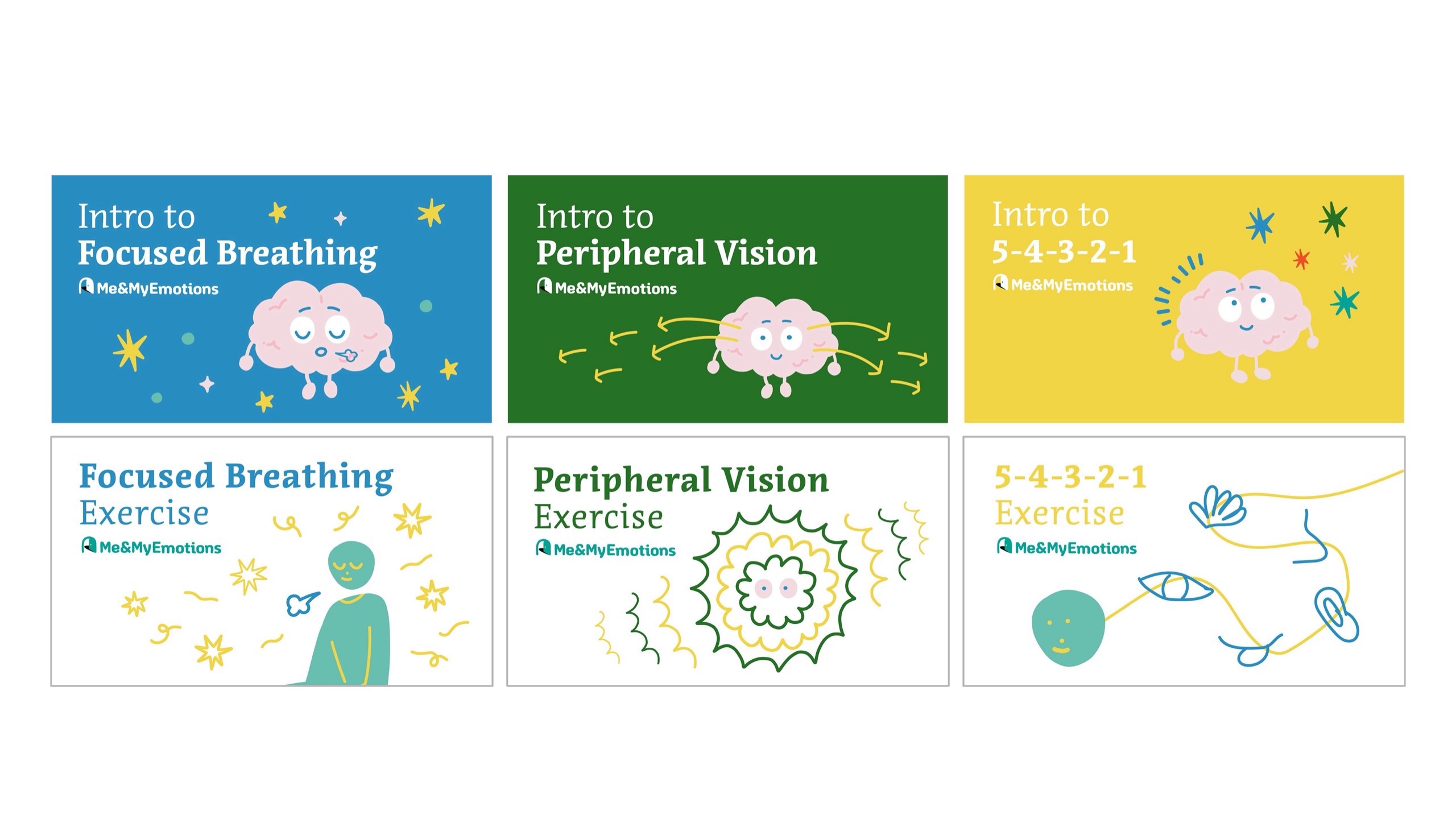
Video lessons – the Learning Room
Here, the Mind Matters curriculum is broken down into 12 video lessons. Each video lesson is paired with an action or exercise that features stylized animations and prompts to guide users through the steps. Videos can be accessed in order or customizable. Once users have watched a certain video, they will receive an achievement badge with the goal of completing the entire program.
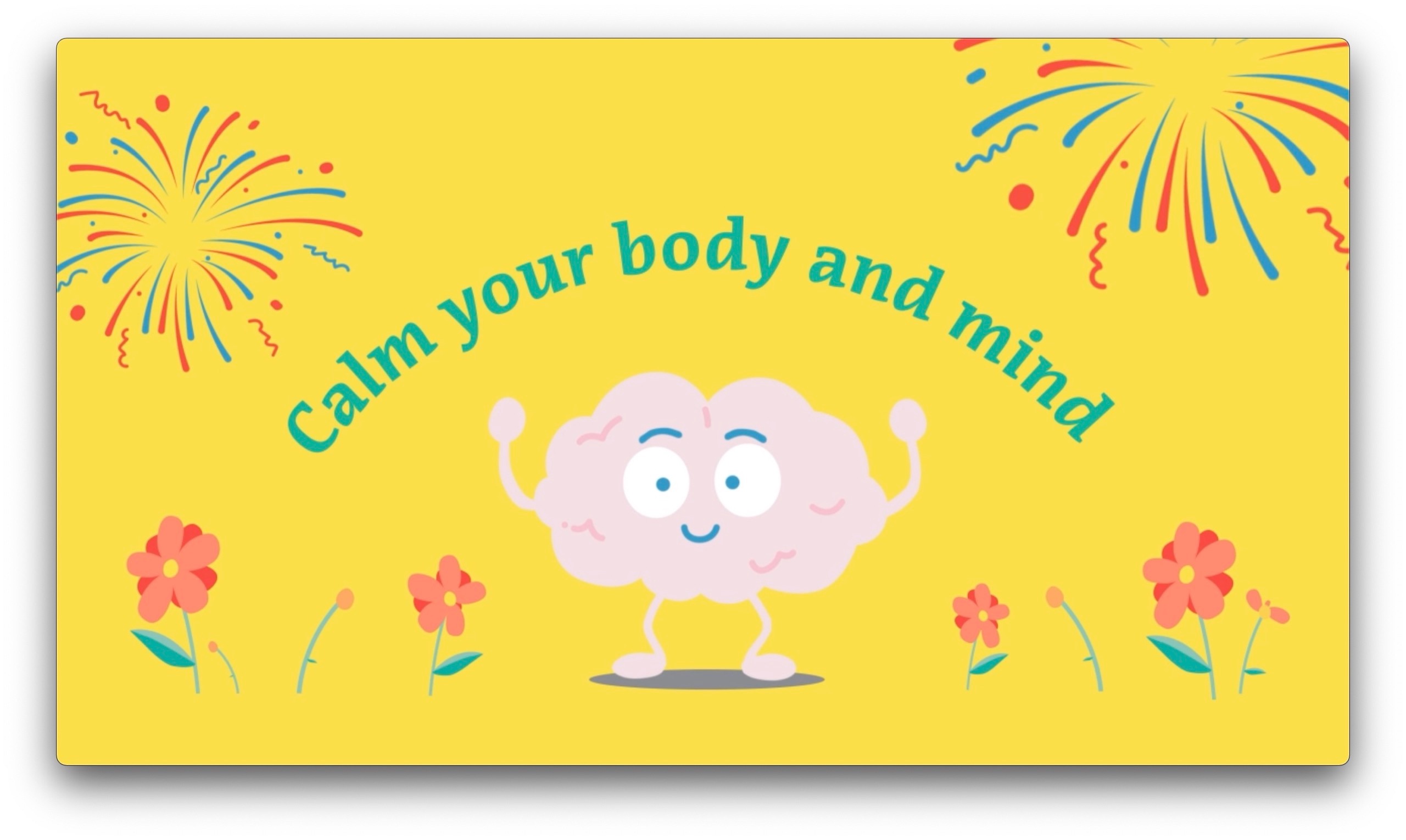
Digital ads
To create cost-effective advertisements, the campaign will use the YouTube platform and target videos by Topic, Category and Keyword. YouTube Ads will feature illustrative original motion graphics that will stay consistent with the brand while capturing the attention of teens.
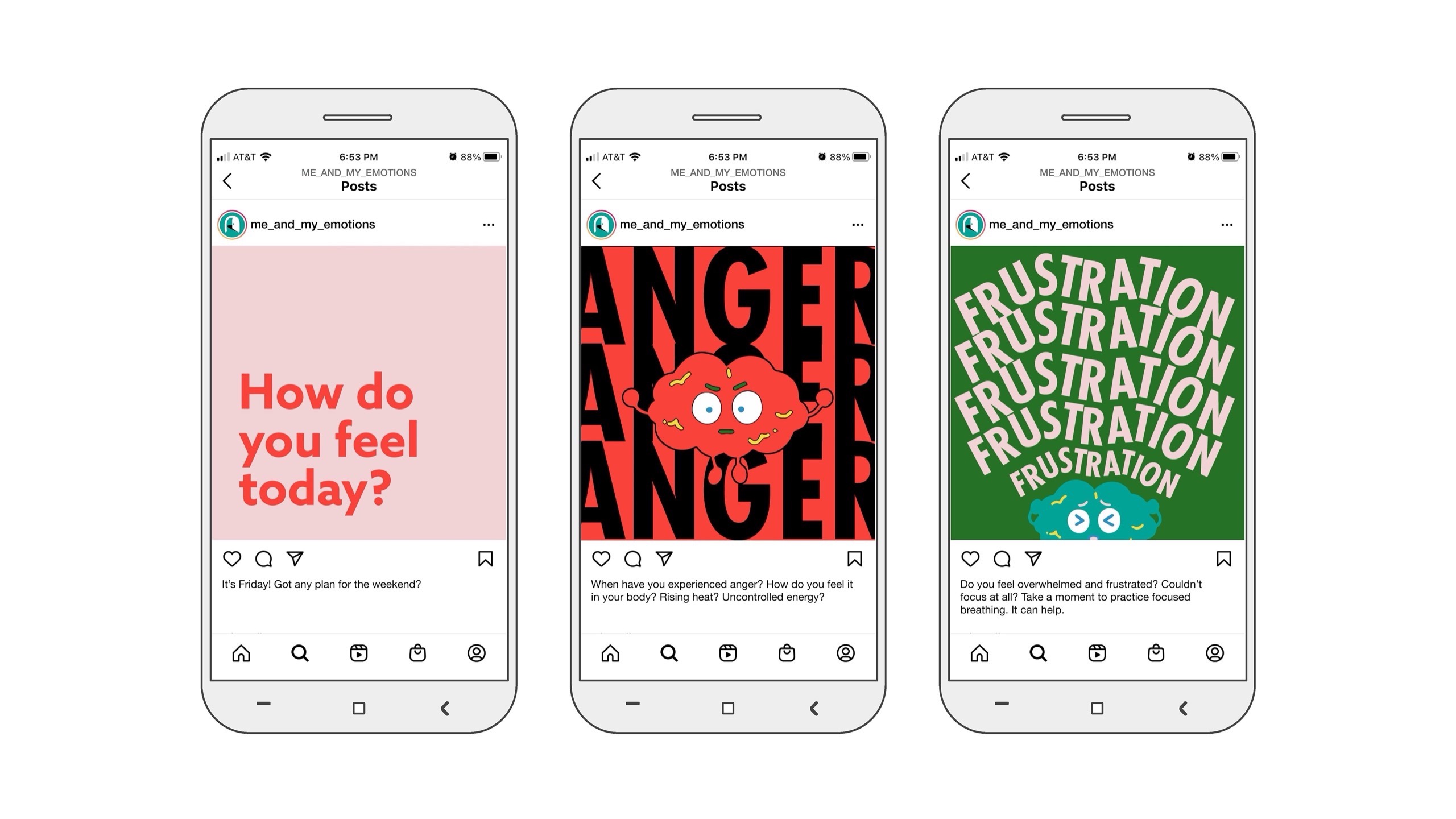
Social media
Instagram and TikTok created posts/stories can include the MME Pink Brain mascot and feature interactive daily challenge questions, daily greetings, resource reminders and carousel images describing steps of MME exercises, all presented in the MME branding style, colors and fonts. The hashtag #MeAndMyEmotions can be created. The remixed website videos can be uploaded as IG stories and link back to the website.
Capitalizing on a current trend in social media, users can create their own “Memogi” face filter that captures facial features but creates a “brand new person.” This filter can be utilized in a peripheral vision video that depicts a person but keeps privacy and security measures in place. The Memogi character can lead users through MME exercises and offer resources.
Two types of social media influencers with mental wellbeing experience/focus can be engaged to drive traffic and name recognition. Micro-influencers will be cost effective but have smaller followings (less than 10K) than popular influencers; depending on the budget, a collaboration strategy would include native videos, hashtag challenges, brand takeovers and branded filters/lens.
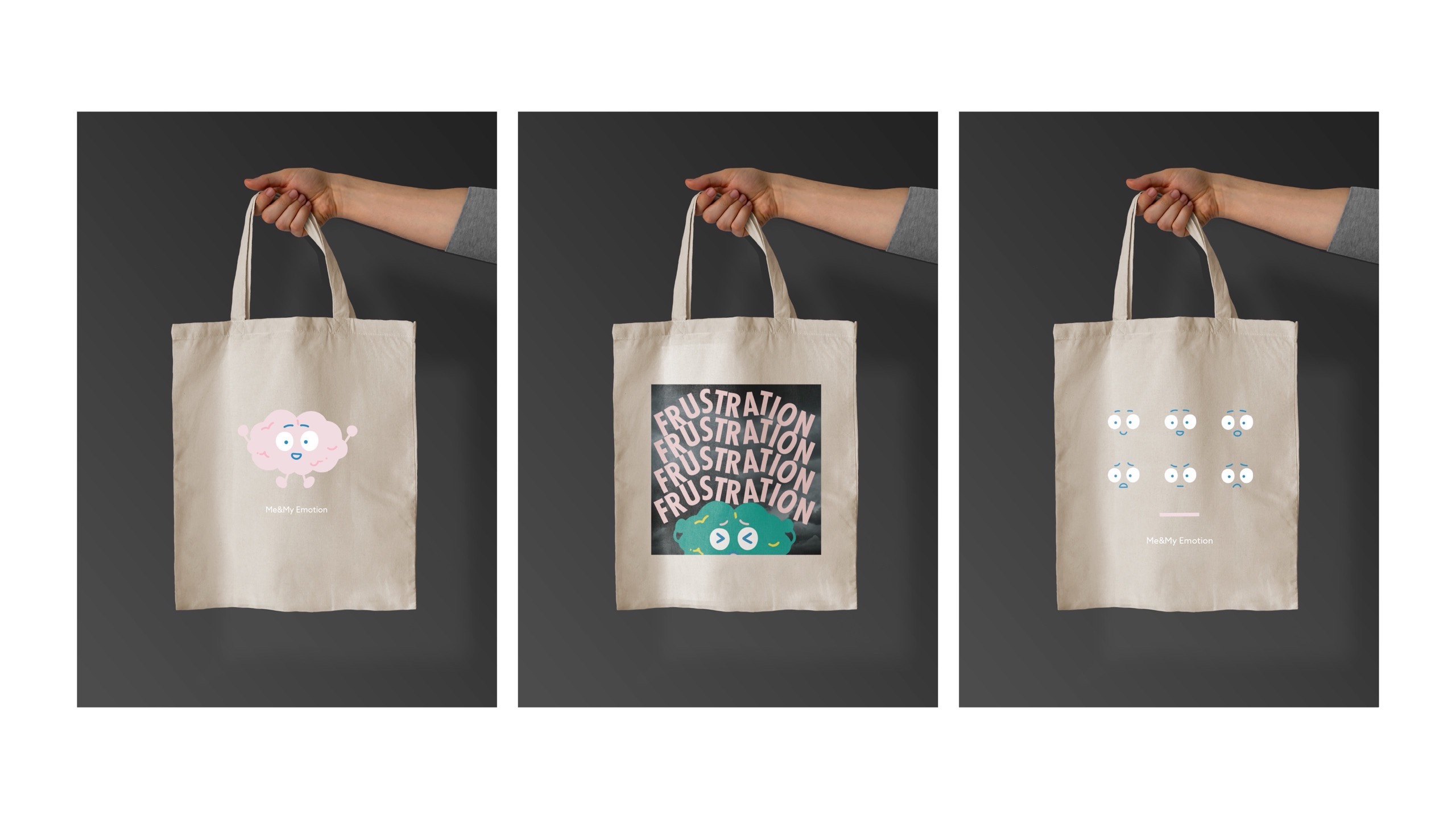
Merchandise
Pins, stickers and tote bags are popular and cost-effective items to produce that connect teen users to the MME brand and its message.
Pins can display a close up of the Pink Brain face along with the hashtag #MeandMyEmotions. Other pins can be colorful versions of the mascot’s face that depict different emotions – red, an angry face; orange worried; blue sad, etc.
Sticker artwork can feature the MME Pink Brain character; depending on budget, stickers can be simple circle cuts or more expensive die-cuts. Other stickers could depict words from the Loving Kindness Exercises: “May you be peaceful and happy,” “May you experience loving kindness,” etc.
Tote bags can come in a variety of artwork; some could incorporate the Pink Brain mascot and the variety of emotions told through eye gestures. Others could depict the mascot opening up a door asking questions such as, “How are you feeling today?” Others totes could display Mind Matters lessons while some totes could encourage users to customize their tote with their own colors.
The merchandise campaign would have the option to connect MME content with popular fashion brands which could appeal to teens and push MME into mainstream recognition. Suggested collaborations would include Hot Topic, Vans, Converse and Zumiez.
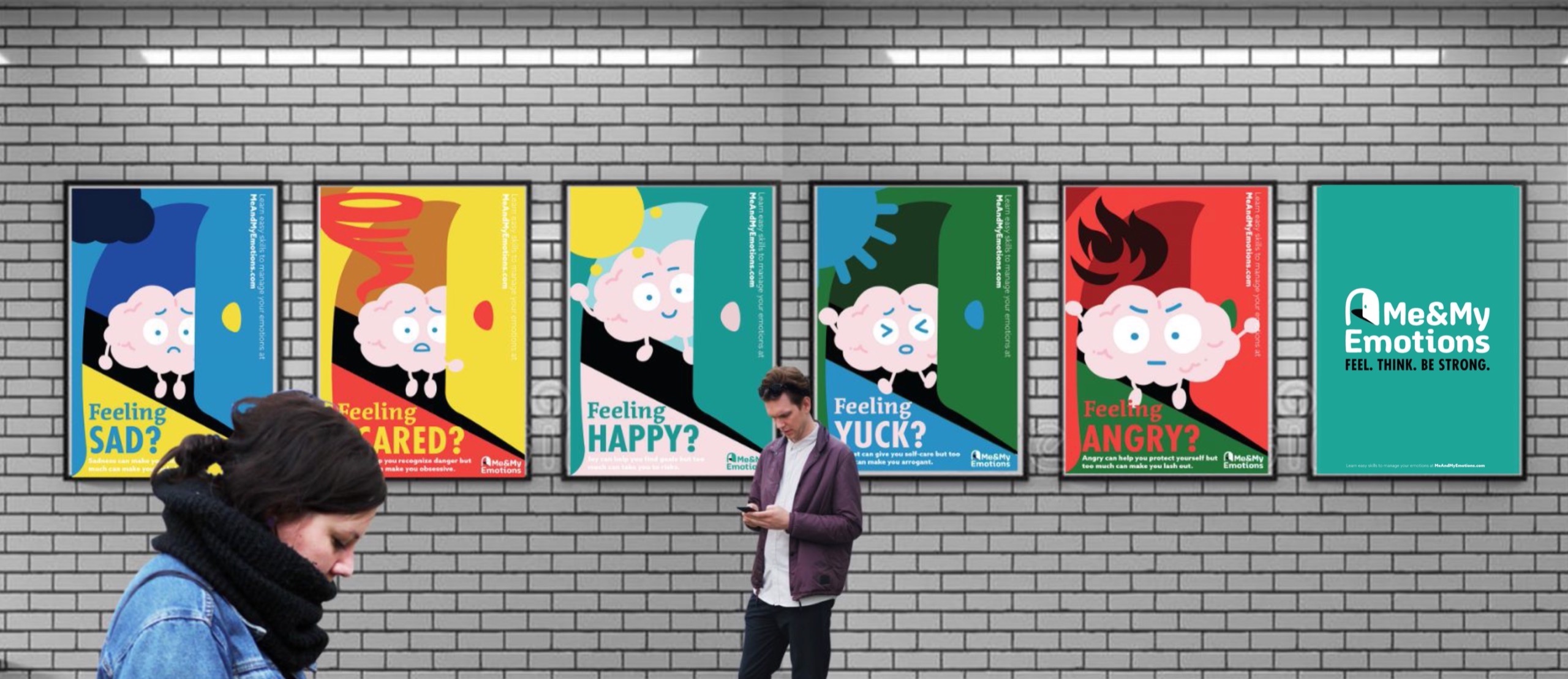
Physical advertising
A poster series would incorporate the Pink Brain mascot coming through a door; different emotions would be depicted by the mascot’s face and background color scheme. A quick sentence would illuminate that emotion and direct readers to the MME website. A summation poster would simply have the MME logo and the tagline: “Feel. Think. Be strong.”
Posters can be applied to interior/exterior school walls.
A perforated poster – an angry Pink Brain – would encourage interaction; as teens peel away squared sections, the imagery underneath of a calm Pink Brain would be revealed.
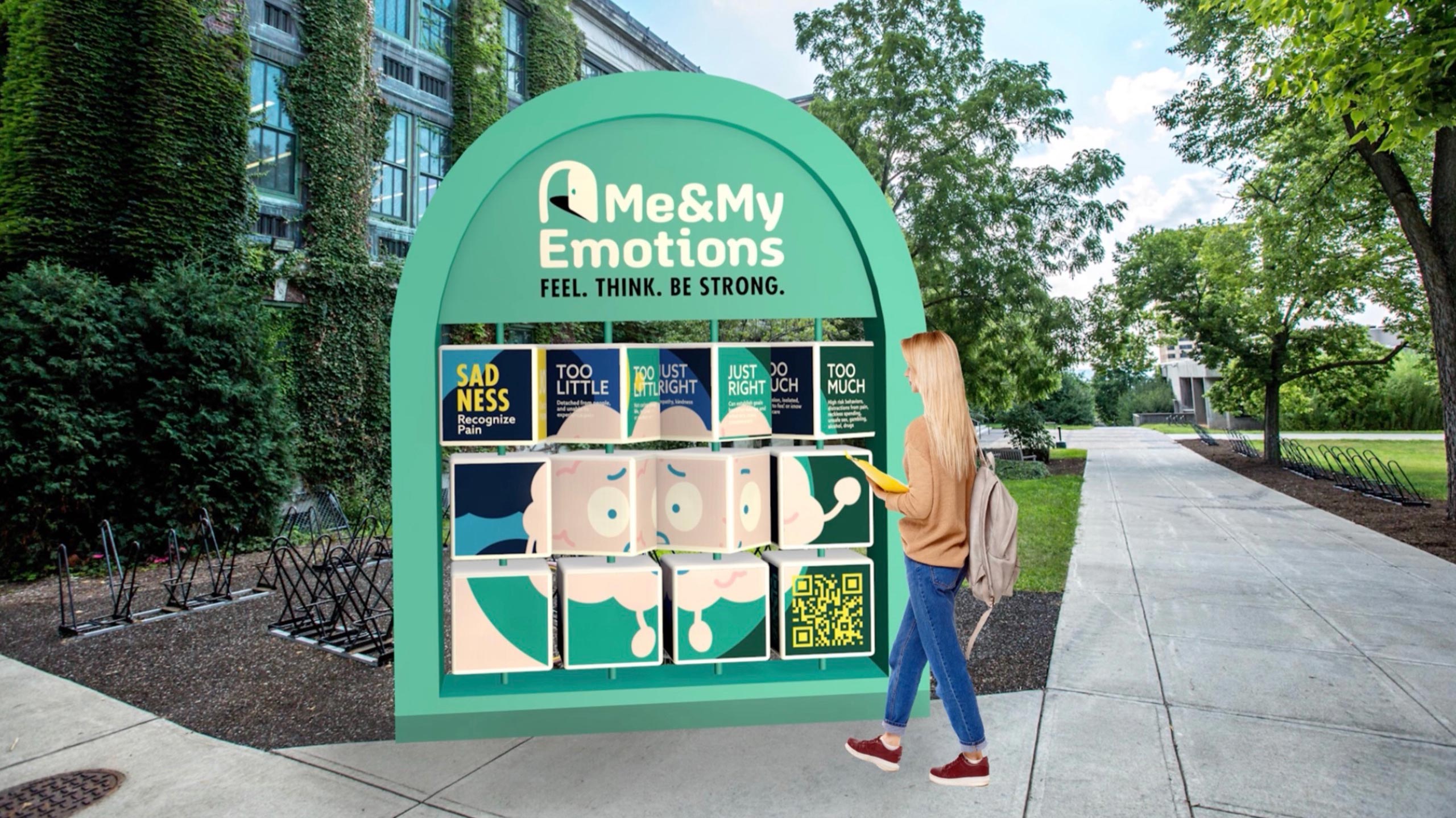
Physical activation
A standalone series of rotatable cubes harkens back to a child’s playground structure, but here, the text/imagery and interactions is directed toward teenage students and can be installed near high schools. As cube sections are spun, viewers are encouraged to consider their current state of emotion; spun again, the cubes relate MME exercises such as the 5-4-3-2-1 “Find 5 objects around you; Listen to 4 different sounds, etc.” Other MME exercises/lesson takeaways are displayed on other spinning cubes.
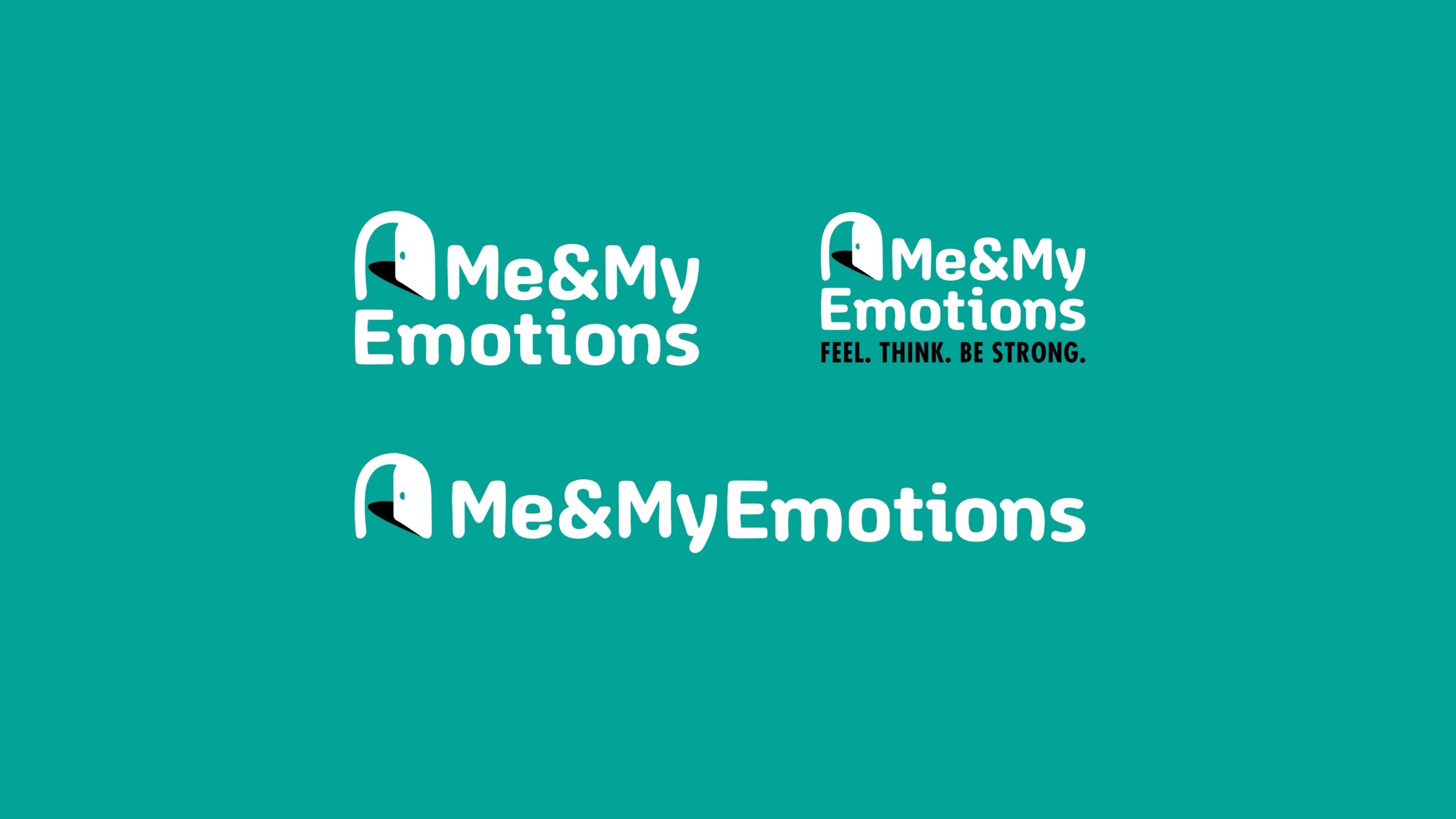
Brand Elements
The MME logo treatment and variations feature an open door motif that symbolizes how the program can help teens unlock open themselves up to a healthier way of living. The tagline “Feel. Think. Be Strong” can be placed underneath the logo.
The MME typography is energizing and friendly; the primary color palette is deep aqua and yellow that creates a mood that is secure, accessible and hopeful. Secondary colors engage (red), empathize (warm pink), are educational (blue) and fresh (green). Gentle yet engaging illustrations (telescopes, boom boxes, calendars, etc.) incorporate the color schemes and are easily recognizable.
The Pink Brain character can display a variety of moods, emotions and expressions through eye brows and mouth shapes as well as arm positions.
“What impressed me about the final presentation was how the students applied their strategic insights into design for multiple online and offline touchpoints, and how they were able to collectively find a cohesive and compelling voice for Me & My Emotions.”
Monica Schlaug, Faculty
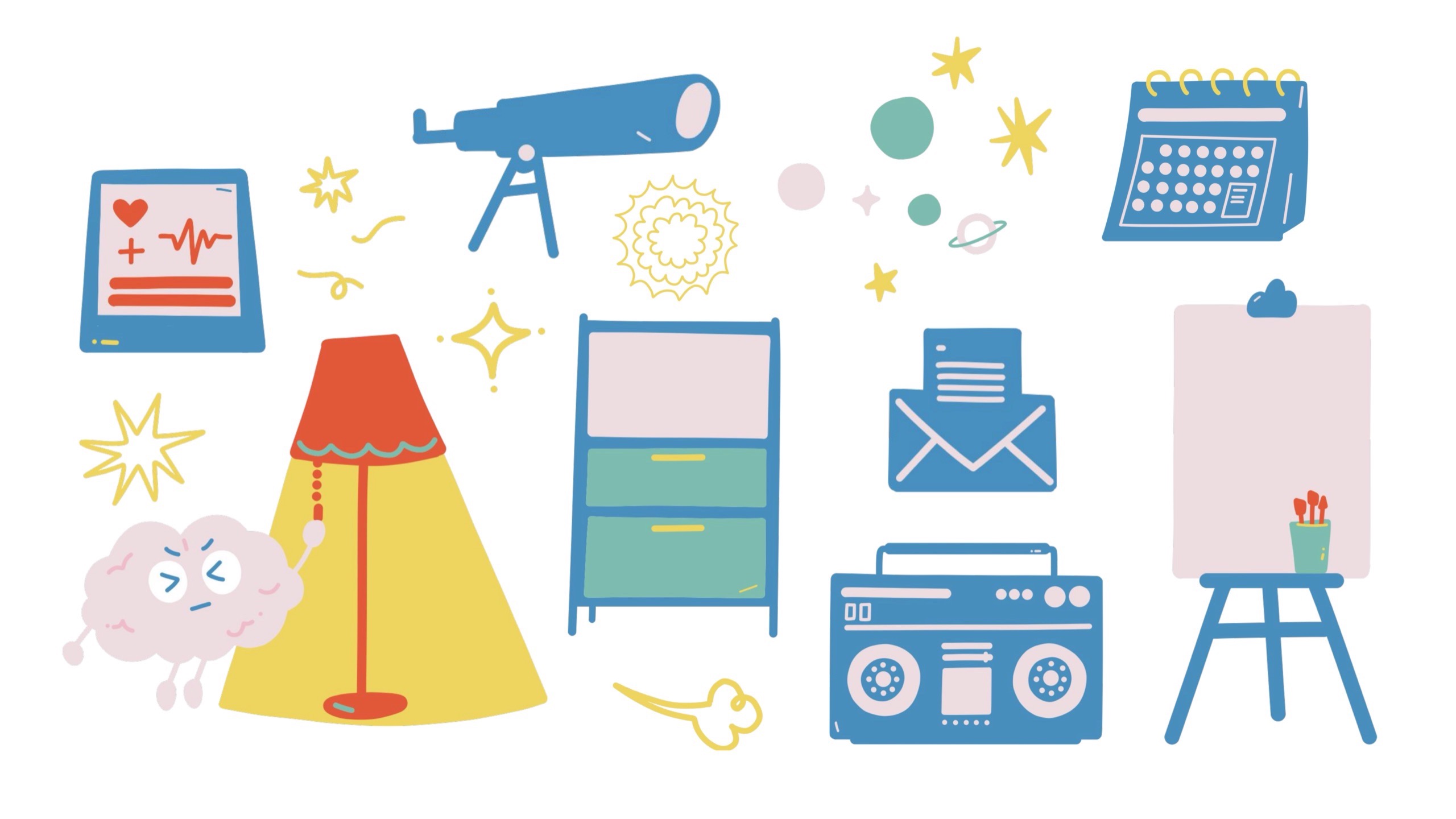
“During Covid-19, the in-person interactions were not permitted, but ArtCenter students, faculty and staff were all very professional and prepared. The studio has a very set timeline for deliverables and the faculty kept the project on task. If this same assignment had been given to an agency, they would not have had the luxury of as much time to research and learn from authorities in the field.”
The Dibble Institute team
NEXT STEPS
After the studio, students Audrey Murty, Amelia Yessayantz and Evan Stalker were awarded Designmatters Fellowships with the Dibble Institute and worked over the summer of 2021 to bring the studio concepts to reality, producing 20+ animated videos and a website. Me & My Emotions was launched in the Fall of 2021.
